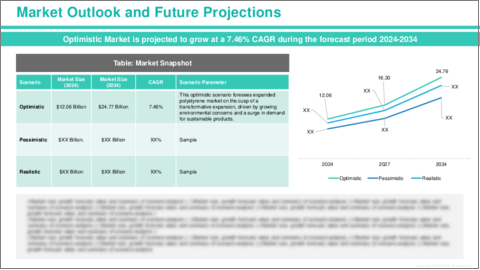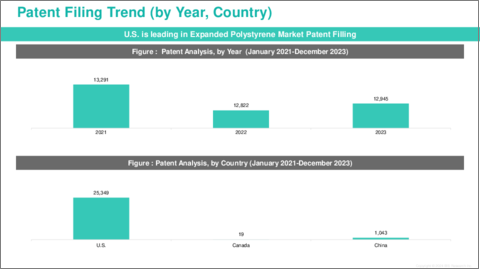|
|
市場調査レポート
商品コード
1520633
発泡ポリスチレン(EPS)市場- 世界と地域別分析:エンドユーザー業界別、タイプ別、地域別 - 分析と予測(2024年~2034年)Expanded Polystyrene (EPS) Market - A Global and Regional Analysis: Focus on End-user Industry, Type, and Region - Analysis and Forecast, 2024-2034 |
||||||
カスタマイズ可能
|
|||||||
| 発泡ポリスチレン(EPS)市場- 世界と地域別分析:エンドユーザー業界別、タイプ別、地域別 - 分析と予測(2024年~2034年) |
|
出版日: 2024年07月25日
発行: BIS Research
ページ情報: 英文 100 Pages
納期: 1~5営業日
|
全表示
- 概要
- 目次
発泡ポリスチレン(EPS)市場は、環境に優しい素材に対する世界の需要に後押しされ、持続可能性と技術革新の岐路に立っています。
リサイクル可能で低衝撃性のポリスチレンを原料とするEPSは、包装、建築、断熱など様々な用途で極めて重要な役割を果たしています。その魅力は、従来の包装材料に比べて二酸化炭素排出量とエネルギー消費量を削減し、環境への影響を軽減できる点にあります。2024年の楽観的シナリオでは、市場規模は120億6,000万米ドルで、CAGR 7.46%で成長し、2034年には247億7,000万米ドルに達すると予測されています。
| 主要市場統計 | |
|---|---|
| 予測期間 | 2024年~2034年 |
| 2024年の評価 | 120億6,000万米ドル |
| 2034年の予測 | 247億7,000万米ドル |
| CAGR | 7.46% |
EPS市場はその成長軌道にもかかわらず、課題、特に環境に配慮した生産プロセスや材料調達に伴う初期コストの上昇に直面しています。しかし、長期的なメリットはこれらの課題を凌駕します。EPSは再生不可能な資源への依存を減らし、世界の持続可能性の目標に合致しているため、包装や建設分野の産業にとって魅力的な選択肢となっています。技術の進歩により生産効率が向上し続け、消費者の嗜好が持続可能なソリューションへとシフトしていく中、EPSは今後数年間で市場での存在感を大幅に拡大する態勢を整えています。
EPSの将来は、持続可能な技術の進歩や消費者の意識の高まりと絡み合っています。EPS生産における技術革新は、コスト削減と環境プロファイルの改善において極めて重要です。こうした技術革新は、規制要件と、環境に優しいパッケージングソリューションに対する消費者の期待の両方を満たす鍵となります。
建設業界は、その優れた断熱特性と軽量性によりEPSの主要な受益者であり、建物のエネルギー効率とカーボンフットプリントの低減に貢献しています。さらに、包装分野では、EPSは輸送中の商品の保護に優れ、代替品と比べて環境への影響を最小限に抑えることができます。
プラスチック廃棄物の削減とリサイクルの促進を目指した世界の取り組みが、EPS市場の成長見通しをさらに後押ししています。EPSはリサイクル可能であるため、さまざまな用途で再利用することができ、持続可能性の信頼性を高め、使い捨てプラスチックに関連する環境負荷を軽減することができます。
結論として、EPS市場は、規制当局の支援の増加、技術の先進化、持続可能なパッケージングソリューションへの消費者の嗜好の変化などを原動力として、大きく成長する態勢にあります。課題にもかかわらず、EPSはより持続可能な経済への移行における礎石であり続け、世界中の産業に多大な環境的利益と長期的価値を提供しています。
当レポートでは、世界の発泡ポリスチレン(EPS)市場について調査し、市場の概要とともに、エンドユーザー業界別、タイプ別、地域別の動向、および市場に参入する企業のプロファイルなどを提供しています。
目次
エグゼクティブサマリー
第1章 市場:業界の展望
- 動向:現在および将来の影響評価
- サプライチェーンの概要
- R&Dレビュー
- 規制状況
- ステークホルダー分析
- 主要な世界的イベントの影響分析
- 市場力学の概要
第2章 発泡ポリスチレン(EPS)市場(用途別)
- 用途のセグメンテーション
- 用途の概要
- 発泡ポリスチレン(EPS)市場(エンドユーザー業界別)
第3章 発泡ポリスチレン(EPS)市場(製品別)
- 製品セグメンテーション
- 製品概要
- 発泡ポリスチレン(EPS)市場(タイプ別)
第4章 発泡ポリスチレン(EPS)市場(地域別)
- 発泡ポリスチレン(EPS)市場(地域別)
- 北米
- 欧州
- アジア太平洋
- その他の地域
第5章 市場-競合ベンチマーキングと企業プロファイル
- 今後の見通し
- 地理的評価
- 企業プロファイル
- NOVA Chemicals Corporate
- Alpek S.A.B. de C.V.
- BASF SE
- BEWI
- Epsilyte LLC
- Kaneka Corporation
- Ravago Petrokimya Uretim AS
- SABIC
- SUNPOR
- Synthos
- Unipol Holland BV
- Versalis SpA
- Wuxi Xingda Foam Plastic New Material Limited
- Loyal Group
- TotalEnergies
- その他の主要メーカー一覧
第6章 調査手法
Introduction to Expanded Polystyrene (EPS) Market
The Expanded Polystyrene (EPS) market stands at a crossroads of sustainability and technological innovation, driven by global demand for environmentally friendly materials. EPS, derived from recyclable and low-impact polystyrene, plays a pivotal role in various applications, including packaging, construction, and insulation. Its appeal lies in its capacity to mitigate environmental impact by reducing carbon emissions and energy consumption compared to conventional packaging materials. In an optimistic scenario in 2024, the market is valued at $12.06 billion and is projected to grow at a CAGR of 7.46%, reaching an estimated $24.77 billion by 2034.
| KEY MARKET STATISTICS | |
|---|---|
| Forecast Period | 2024 - 2034 |
| 2024 Evaluation | $12.06 Billion |
| 2034 Forecast | $24.77 Billion |
| CAGR | 7.46% |
Despite its growing trajectory, the EPS market encounters challenges, particularly the higher initial costs associated with eco-friendly production processes and material sourcing. However, the long-term benefits outweigh these challenges. EPS reduces dependency on non-renewable resources and aligns with global sustainability objectives, making it an attractive choice for industries across packaging and construction sectors. As technological advancements continue to enhance production efficiencies and consumer preferences shift towards sustainable solutions, EPS is poised to significantly expand its market presence in the years ahead.
The future of EPS is intertwined with advancements in sustainable technology and increasing consumer awareness. Innovations in EPS production is crucial in driving down costs and improving its environmental profile. These innovations are key to meeting both regulatory requirements and consumer expectations for eco-friendly packaging solutions.
The construction industry is a major beneficiary of EPS due to its excellent insulation properties and lightweight nature, which contribute to energy efficiency and lower carbon footprints in buildings. Moreover, in the packaging sector, EPS offers superior protection for goods during transit while minimizing environmental impact compared to alternatives.
Global initiatives aimed at reducing plastic waste and promoting recycling further bolster the EPS market's growth prospects. The recyclability of EPS ensures that it can be reused in various applications, enhancing its sustainability credentials and reducing environmental burdens associated with single-use plastics.
In conclusion, the EPS market is poised for significant growth driven by increasing regulatory support, technological advancements, and shifting consumer preferences towards sustainable packaging solutions. Despite challenges, EPS remains a cornerstone in the transition towards a more sustainable economy, offering substantial environmental benefits and long-term value to industries worldwide.
Market Segmentation
Segmentation 1: by End-user Industry
- Packaging
- Electrical and Electronics
- Building and Construction
- Medical
- Others
Segmentation 2: by Type
- White
- Grey/ Black
Segmentation 3: by Region
- North America
- Europe
- Asia-Pacific
- Rest-of-the-World
How can this report add value to an organization?
Product/Innovation Strategy: The global expanded polystyrene (EPS) market has been extensively segmented based on various categories, such as end-user industry, type, and region. This can help readers get a clear overview of which segments account for the largest share and which ones are well-positioned to grow in the coming years.
Competitive Strategy: A detailed competitive benchmarking of the players operating in the global expanded polystyrene (EPS) market has been done to help the reader understand how players stack against each other, presenting a clear market landscape. Additionally, comprehensive competitive strategies such as partnerships, agreements, and collaborations will aid the reader in understanding the untapped revenue pockets in the market.
Key Market Players and Competition Synopsis
The companies that are profiled have been selected based on thorough secondary research, which includes analyzing company coverage, product portfolio, market penetration, and insights gathered from primary experts.
Some of the prominent companies in this market are:
- BASF SE
- Alpek S.A.B. de C.V.
- Kaneka Corporation
- BEWI
- SUNPOR
- Synthos
- TotalEnergies
- NOVA Chemicals Corporate
- Unipol Holland BV
Key Questions Answered in this Report:
- What are the main factors driving the demand for expanded polystyrene (EPS) market?
- What are the major patents filed by the companies active in the expanded polystyrene (EPS) market?
- Who are the key players in the expanded polystyrene (EPS) market, and what are their respective market shares?
- What partnerships or collaborations are prominent among stakeholders in the expanded polystyrene (EPS) market?
- What are the strategies adopted by the key companies to gain a competitive edge in expanded polystyrene (EPS) market?
- What is the futuristic outlook for the expanded polystyrene (EPS) market in terms of growth potential?
- What is the current estimation of the expanded polystyrene (EPS) market and what growth trajectory is projected from 2024 to 2034?
- Which application, and product segment is expected to lead the market over the forecast period (2024-2034)?
- Which regions demonstrate the highest adoption rates for expanded polystyrene (EPS) market, and what factors contribute to their leadership?
Table of Contents
Executive Summary
Scope and Definition
Market/Product Definition
Key Questions Answered
Analysis and Forecast Note
1. Markets: Industry Outlook
- 1.1 Trends: Current and Future Impact Assessment
- 1.2 Supply Chain Overview
- 1.2.1 Value Chain Analysis
- 1.2.2 Pricing Forecast
- 1.3 R&D Review
- 1.3.1 Patent Filing Trend by Country, by Company
- 1.4 Regulatory Landscape
- 1.5 Stakeholder Analysis
- 1.5.1 Use Case
- 1.5.2 End User and Buying Criteria
- 1.6 Impact Analysis for Key Global Events
- 1.7 Market Dynamics Overview
- 1.7.1 Market Drivers
- 1.7.2 Market Restraints
- 1.7.3 Market Opportunities
2. Expanded Polystyrene (EPS) Market (by Application)
- 2.1 Application Segmentation
- 2.2 Application Summary
- 2.3 Expanded Polystyrene (EPS) Market (by End-user Industry)
- 2.3.1 Packaging
- 2.3.2 Electrical and Electronics
- 2.3.3 Building and Construction
- 2.3.4 Medical
- 2.3.5 Others
3. Expanded Polystyrene (EPS) Market (by Product)
- 3.1 Product Segmentation
- 3.2 Product Summary
- 3.3 Expanded Polystyrene (EPS) Market (by Type)
- 3.3.1 White
- 3.3.2 Grey/ Black
4. Expanded Polystyrene (EPS) Market (by Region)
- 4.1 Expanded Polystyrene (EPS) Market (by Region)
- 4.2 North America
- 4.2.1 Regional Overview
- 4.2.2 Driving Factors for Market Growth
- 4.2.3 Factors Challenging the Market
- 4.2.4 Application
- 4.2.5 Product
- 4.2.6 North America Expanded Polystyrene (EPS) Market (by Country)
- 4.2.6.1 U.S.
- 4.2.6.1.1 Market by Application
- 4.2.6.1.2 Market by Product
- 4.2.6.2 Canada
- 4.2.6.2.1 Market by Application
- 4.2.6.2.2 Market by Product
- 4.2.6.3 Mexico
- 4.2.6.3.1 Market by Application
- 4.2.6.3.2 Market by Product
- 4.2.6.1 U.S.
- 4.3 Europe
- 4.3.1 Regional Overview
- 4.3.2 Driving Factors for Market Growth
- 4.3.3 Factors Challenging the Market
- 4.3.4 Application
- 4.3.5 Product
- 4.3.6 Europe Expanded Polystyrene (EPS) Market (by Country)
- 4.3.6.1 Germany
- 4.3.6.1.1 Market by Application
- 4.3.6.1.2 Market by Product
- 4.3.6.2 France
- 4.3.6.2.1 Market by Application
- 4.3.6.2.2 Market by Product
- 4.3.6.3 U.K.
- 4.3.6.3.1 Market by Application
- 4.3.6.3.2 Market by Product
- 4.3.6.4 Italy
- 4.3.6.4.1 Market by Application
- 4.3.6.4.2 Market by Product
- 4.3.6.5 Rest-of-Europe
- 4.3.6.5.1 Market by Application
- 4.3.6.5.2 Market by Product
- 4.3.6.1 Germany
- 4.4 Asia-Pacific
- 4.4.1 Regional Overview
- 4.4.2 Driving Factors for Market Growth
- 4.4.3 Factors Challenging the Market
- 4.4.4 Application
- 4.4.5 Product
- 4.4.6 Asia-Pacific Expanded Polystyrene (EPS) Market (by Country)
- 4.4.6.1 China
- 4.4.6.1.1 Market by Application
- 4.4.6.1.2 Market by Product
- 4.4.6.2 Japan
- 4.4.6.2.1 Market by Application
- 4.4.6.2.2 Market by Product
- 4.4.6.3 India
- 4.4.6.3.1 Market by Application
- 4.4.6.3.2 Market by Product
- 4.4.6.4 South Korea
- 4.4.6.4.1 Market by Application
- 4.4.6.4.2 Market by Product
- 4.4.6.5 Rest-of-Asia-Pacific
- 4.4.6.5.1 Market by Application
- 4.4.6.5.2 Market by Product
- 4.4.6.1 China
- 4.5 Rest-of-the-World
- 4.5.1 Regional Overview
- 4.5.2 Driving Factors for Market Growth
- 4.5.3 Factors Challenging the Market
- 4.5.4 Application
- 4.5.5 Product
- 4.5.6 Rest-of-the-World Expanded Polystyrene (EPS) Market (by Country)
- 4.5.6.1 South America
- 4.5.6.1.1 Market by Application
- 4.5.6.1.2 Market by Product
- 4.5.6.2 Middle East and Africa
- 4.5.6.2.1 Market by Application
- 4.5.6.2.2 Market by Product
- 4.5.6.1 South America
5. Markets - Competitive Benchmarking & Company Profiles
- 5.1 Next Frontiers
- 5.2 Geographic Assessment
- 5.3 Company Profiles
- 5.3.1 NOVA Chemicals Corporate
- 5.3.1.1 Overview
- 5.3.1.2 Top Products/Product Portfolio
- 5.3.1.3 Top Competitors
- 5.3.1.4 Target Customers
- 5.3.1.5 Key Personnel
- 5.3.1.6 Analyst View
- 5.3.1.7 Market Share
- 5.3.2 Alpek S.A.B. de C.V.
- 5.3.2.1 Overview
- 5.3.2.2 Top Products/Product Portfolio
- 5.3.2.3 Top Competitors
- 5.3.2.4 Target Customers
- 5.3.2.5 Key Personnel
- 5.3.2.6 Analyst View
- 5.3.2.7 Market Share
- 5.3.3 BASF SE
- 5.3.3.1 Overview
- 5.3.3.2 Top Products/Product Portfolio
- 5.3.3.3 Top Competitors
- 5.3.3.4 Target Customers
- 5.3.3.5 Key Personnel
- 5.3.3.6 Analyst View
- 5.3.3.7 Market Share
- 5.3.4 BEWI
- 5.3.4.1 Overview
- 5.3.4.2 Top Products/Product Portfolio
- 5.3.4.3 Top Competitors
- 5.3.4.4 Target Customers
- 5.3.4.5 Key Personnel
- 5.3.4.6 Analyst View
- 5.3.4.7 Market Share
- 5.3.5 Epsilyte LLC
- 5.3.5.1 Overview
- 5.3.5.2 Top Products/Product Portfolio
- 5.3.5.3 Top Competitors
- 5.3.5.4 Target Customers
- 5.3.5.5 Key Personnel
- 5.3.5.6 Analyst View
- 5.3.5.7 Market Share
- 5.3.6 Kaneka Corporation
- 5.3.6.1 Overview
- 5.3.6.2 Top Products/Product Portfolio
- 5.3.6.3 Top Competitors
- 5.3.6.4 Target Customers
- 5.3.6.5 Key Personnel
- 5.3.6.6 Analyst View
- 5.3.6.7 Market Share
- 5.3.7 Ravago Petrokimya Uretim AS
- 5.3.7.1 Overview
- 5.3.7.2 Top Products/Product Portfolio
- 5.3.7.3 Top Competitors
- 5.3.7.4 Target Customers
- 5.3.7.5 Key Personnel
- 5.3.7.6 Analyst View
- 5.3.7.7 Market Share
- 5.3.8 SABIC
- 5.3.8.1 Overview
- 5.3.8.2 Top Products/Product Portfolio
- 5.3.8.3 Top Competitors
- 5.3.8.4 Target Customers
- 5.3.8.5 Key Personnel
- 5.3.8.6 Analyst View
- 5.3.8.7 Market Share
- 5.3.9 SUNPOR
- 5.3.9.1 Overview
- 5.3.9.2 Top Products/Product Portfolio
- 5.3.9.3 Top Competitors
- 5.3.9.4 Target Customers
- 5.3.9.5 Key Personnel
- 5.3.9.6 Analyst View
- 5.3.9.7 Market Share
- 5.3.10 Synthos
- 5.3.10.1 Overview
- 5.3.10.2 Top Products/Product Portfolio
- 5.3.10.3 Top Competitors
- 5.3.10.4 Target Customers
- 5.3.10.5 Key Personnel
- 5.3.10.6 Analyst View
- 5.3.10.7 Market Share
- 5.3.11 Unipol Holland BV
- 5.3.11.1 Overview
- 5.3.11.2 Top Products/Product Portfolio
- 5.3.11.3 Top Competitors
- 5.3.11.4 Target Customers
- 5.3.11.5 Key Personnel
- 5.3.11.6 Analyst View
- 5.3.11.7 Market Share
- 5.3.12 Versalis SpA
- 5.3.12.1 Overview
- 5.3.12.2 Top Products/Product Portfolio
- 5.3.12.3 Top Competitors
- 5.3.12.4 Target Customers
- 5.3.12.5 Key Personnel
- 5.3.12.6 Analyst View
- 5.3.12.7 Market Share
- 5.3.13 Wuxi Xingda Foam Plastic New Material Limited
- 5.3.13.1 Overview
- 5.3.13.2 Top Products/Product Portfolio
- 5.3.13.3 Top Competitors
- 5.3.13.4 Target Customers
- 5.3.13.5 Key Personnel
- 5.3.13.6 Analyst View
- 5.3.13.7 Market Share
- 5.3.14 Loyal Group
- 5.3.14.1 Overview
- 5.3.14.2 Top Products/Product Portfolio
- 5.3.14.3 Top Competitors
- 5.3.14.4 Target Customers
- 5.3.14.5 Key Personnel
- 5.3.14.6 Analyst View
- 5.3.14.7 Market Share
- 5.3.15 TotalEnergies
- 5.3.15.1 Overview
- 5.3.15.2 Top Products/Product Portfolio
- 5.3.15.3 Top Competitors
- 5.3.15.4 Target Customers
- 5.3.15.5 Key Personnel
- 5.3.15.6 Analyst View
- 5.3.15.7 Market Share
- 5.3.1 NOVA Chemicals Corporate
- 5.4 List of Other Key Manufacturers






